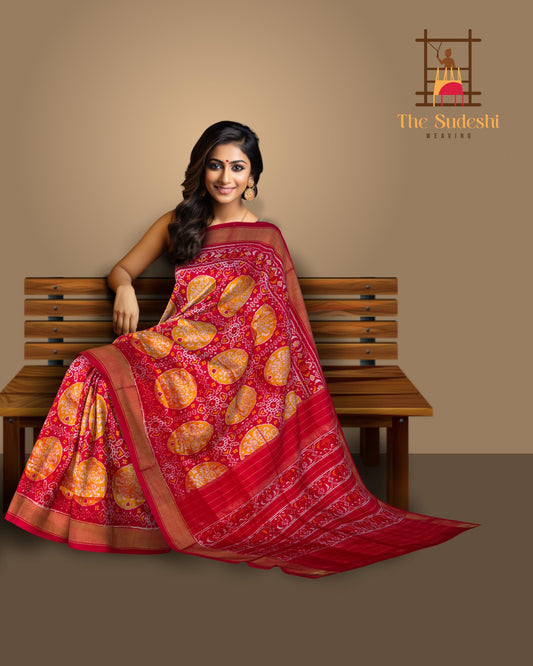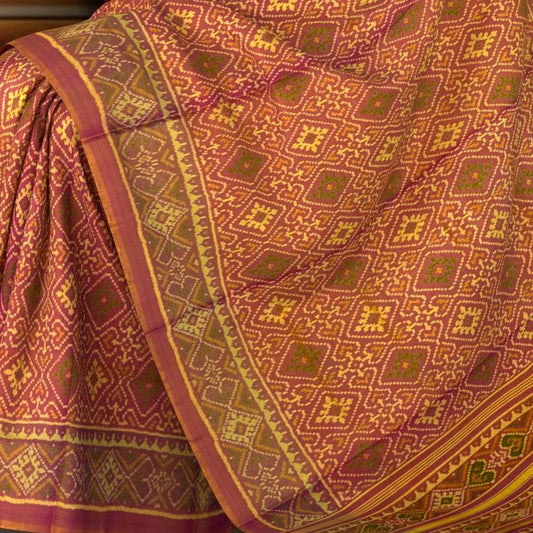Kanchipuram Silk Sarees: What Sets Them Apart from Other Traditional Garments
When it comes to Indian traditional attire, few garments command as much admiration and respect as the Kanchipuram silk saree. Known for its unparalleled craftsmanship, vibrant colors, and luxurious texture, the Kanchipuram silk saree holds a special place not just in South Indian culture but across the world. But what makes this saree so unique compared to other traditional garments? In this blog, we will delve into the intricate details that set Kanchipuram silk sarees apart from other handwoven fabrics, shedding light on their historical significance, craftsmanship, and enduring appeal.
1. A Legacy Rooted in Tradition
The history of Kanchipuram silk sarees dates back more than 400 years, with origins tied to the ancient town of Kanchipuram in Tamil Nadu, India. Kanchipuram, often called the "Silk City," was a thriving center for weaving during the reign of the Pallava dynasty. The weavers of this region, traditionally referred to as “Pattunoolkaarar,” have passed down their craft through generations, preserving techniques that remain largely unchanged to this day.
Compared to other traditional garments, Kanchipuram silk sarees are steeped in history. Each saree tells a story of cultural heritage, skillful artistry, and devotion to time-honored traditions. This rich legacy alone makes the Kanchipuram silk saree unique and distinguishes it from other traditional Indian garments.
2. Superior Quality of Silk
One of the most significant aspects of Kanchipuram silk sarees is the type of silk used in their making. Kanchipuram sarees are crafted from pure mulberry silk, known for its strength, luster, and texture. The silk used in these sarees is sourced from Karnataka, ensuring a superior level of quality.
In contrast to other silk sarees like Banarasi or Mysore silk, the hallmark of Kanchipuram sarees lies in their durability. It’s often said that a genuine Kanchipuram silk saree can last a lifetime, making it a worthy heirloom passed down through generations. The silk threads are heavier and more tightly woven than those found in many other types of silk sarees, giving Kanchipuram sarees their characteristic weight and sheen.
3. Intricate Weaving Techniques
Kanchipuram silk sarees are woven using traditional looms that require exceptional skill and precision. The body, border, and pallu (the drape section) of the saree are woven separately and then joined together with a technique known as the "Korvai" or interlocking weaving technique. The joint is so seamless that it is often said, "If a Kanchipuram saree tears, it will tear along the joint."
The uniqueness of this technique sets Kanchipuram silk sarees apart from other traditional sarees like Chanderi, Patola, or Banarasi, where the border and body are often woven together. The interwoven gold and silver zari threads, combined with vibrant silk, add to the saree’s grandeur, making it ideal for weddings, festivals, and other significant celebrations.
4. Rich Zari Work
Zari is another defining feature of Kanchipuram silk sarees. Made from fine gold or silver threads, zari embellishments are used to create intricate designs along the borders and pallus. The zari used in authentic Kanchipuram sarees is traditionally sourced from Gujarat, and it lends a luxurious, regal touch to the fabric.
Unlike other sarees where zari work is often minimal or understated, the grandeur of Kanchipuram silk sarees lies in their elaborate, wide borders adorned with opulent zari patterns. These designs are often inspired by temple architecture, floral motifs, and mythical figures, adding an element of timeless beauty to the saree.
5. Vibrant Colors and Traditional Motifs
Another distinctive feature of Kanchipuram silk sarees is their striking color palette. The use of contrasting hues, like deep reds, vibrant greens, royal blues, and rich yellows, gives these sarees a visual appeal that is hard to miss. The dyeing process involves natural, eco-friendly dyes that ensure the saree retains its color for years.
Motifs inspired by temples, nature, and mythology are integral to the design of Kanchipuram sarees. Common motifs include peacocks, elephants, lotuses, and other symbols of South Indian culture. These motifs, often woven in gold or silver threads, enhance the saree's aesthetic appeal and represent a deep connection to the region's heritage.
6. Symbol of Status and Prestige
Owning a Kanchipuram silk saree is often seen as a symbol of wealth, status, and prestige. Traditionally, these sarees were worn by royalty and aristocrats, and they continue to hold a high social standing even today. The price of an authentic Kanchipuram saree can range from thousands to several lakhs, depending on the intricacy of the design, the purity of the silk, and the amount of zari work involved.
In comparison, other traditional garments, such as the Paithani saree from Maharashtra or the Banarasi silk saree from Varanasi, while also prestigious, do not carry the same weight of tradition and status that Kanchipuram silk sarees do in South India. For many, owning a Kanchipuram saree is not just about wearing a beautiful garment—it's about embodying a rich cultural history.
7. Versatility for Special Occasions
Kanchipuram silk sarees are often chosen for auspicious occasions such as weddings, temple rituals, and festivals. The intricate design, bold colors, and regal appearance make these sarees the perfect choice for bridal attire. In fact, in South Indian weddings, the bride’s Kanchipuram silk saree is often one of the most significant parts of the wedding trousseau, symbolizing purity and prosperity.
While other traditional garments like Bandhani or Patola sarees are also worn during special occasions, Kanchipuram silk sarees stand out due to their grandeur and cultural importance in South India. Their ability to make a statement at any event, while retaining a connection to heritage, gives them a timeless appeal.
8. A Handwoven Masterpiece
At its heart, each Kanchipuram silk saree is a handwoven masterpiece that takes anywhere from 7 days to several months to complete, depending on the complexity of the design. The weavers put immense dedication and craftsmanship into creating these sarees, using techniques passed down over centuries.
While mass-produced garments have become common in the global fashion industry, the handwoven nature of Kanchipuram silk sarees ensures that each piece is one-of-a-kind. This makes them distinct from other traditional garments, which may rely more heavily on machine production or simpler weaving methods.
9. Sustainability and Ethical Production
In an age where fast fashion and unethical production practices dominate the clothing industry, Kanchipuram silk sarees offer a more sustainable and ethical alternative. These sarees are handwoven using natural fibers and dyes, supporting the livelihood of local artisans and preserving a centuries-old craft.
Compared to other traditional garments, Kanchipuram silk sarees are an example of slow fashion, focusing on quality, craftsmanship, and sustainability rather than mass production. This commitment to ethical production further enhances their uniqueness in today’s global fashion landscape.
Conclusion
Kanchipuram silk sarees are more than just a piece of clothing—they are a symbol of tradition, artistry, and cultural pride. Their superior quality, intricate craftsmanship, and historical significance set them apart from other traditional garments, making them a cherished heirloom for generations to come. Whether worn for a wedding or displayed as a work of art, the elegance of a Kanchipuram silk saree remains unmatched. For anyone looking to experience the true essence of Indian heritage, there is no garment more fitting than the timeless Kanchipuram silk saree.







Leave a comment
Please note, comments need to be approved before they are published.